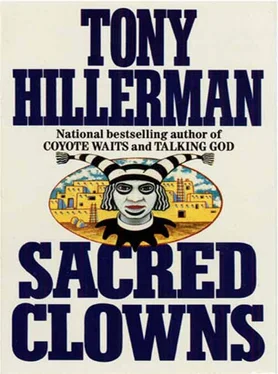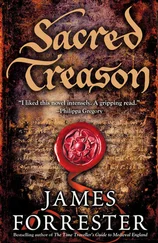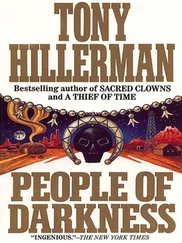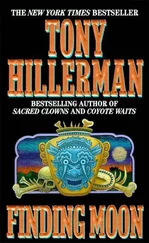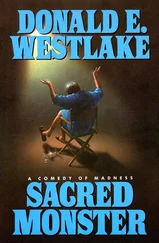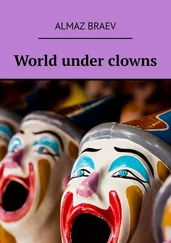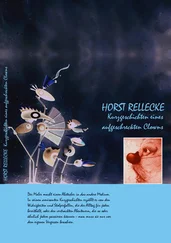What was wrong with him? Why this lousy mood? He knew why. Her name was Janet. But what was her clan? And what the hell was he going to do about it? He didn’t know that. He couldn’t decide what he would do until he knew for certain that he had to decide. First he was going to catch this hit-and-run son-of-a-bitch and then he was going to drive back to Frank Sam Nakai’s place and find out what his uncle had learned. And if his uncle had learned nothing yet – had not yet gone to find the old man who was supposed to know – then he would take Hosteen Nakai to find the old man. Or if his uncle wouldn’t go, he would go himself. He didn’t want to wait.
But it is a policeman’s fate to wait. The working day had not yet ended at the produce warehouses. He cruised slowly through the gravel parking lot, looking for a dark green pickup truck with an ernie is the greatest bumper sticker. There were seven greens among the ranks of trucks and cars, three of them about the right vintage to match the description. If any of them had ever worn the bumper sticker, they weren’t wearing it now.
Chee parked his own pickup where it was partly concealed by an old Chevy conversion van, then glanced at his watch. Seven minutes until five, when the warehouse closed. He sat, not thinking of Janet Pete. He switched on the radio, still tuned to KNDN. A group Chee remembered hearing at a Tuba City Girl Dance was singing a lament about a woman who loved them, but loving them or not, had still stolen their Chevy Blazer. All was in Navajo except the truck’s trade name. The reader of the commercial that followed had a similar problem – there are no Navajo nouns for Purina Pig Chow.
A door at the side of the warehouse slid open. A man emerged wearing coveralls, followed by a procession of other men. Still more men emerged from around the building, with a scattering of women. Chee scanned them, studying them without knowing what he was looking for. A medium-sized, middle-aged, Navajo male. That narrowed it a little. It left out the women, and the very tall, and the very round, and the young bucks whom Ellie would definitely have been able to describe in more detail. Eight or ten fit the medium-middle category – probably more. One of them was standing beside the warehouse door, holding a clipboard, discussing something with two younger workers. Another was walking almost directly toward Chee. He gave Chee a glance and then climbed into the van and started the engine. Chee looked back at the man with the clipboard. Probably a foreman. He was wearing jeans and a jean jacket and a long-billed cap. The bill seemed to be bent sharply upward as if the cardboard stiffener in it had been broken.
“Aah,” Chee said. He leaned forward. Staring. Too far away. He started the pickup engine and eased it forward into the stream of vehicles leaving the lot, then turned out of the traffic flow to coast past the door. The man was still talking to the two, his back turned. Chee drove past the doorway, circled, and parked again where he could watch Clipboard. The man was still talking, his cap still met the description. But a bent-billed cap is scanty proof. The truck would be crucial to any chance of getting a conviction. Where had the man parked it?
At the warehouse door, the conversation ended. Clipboard disappeared inside. The two young men split. One disappeared around the warehouse and the other walked along the wall toward Chee. He was grinning. Chee got out of his pickup, glad he wasn’t wearing his uniform.
“That guy you were talking to,” he said. “With the clipboard. Was that Billy Tsossie?”
“You mean the foreman?” He looked back toward the warehouse door, now closing. “No. His name’s Hoski. Clement Hoski.”
“Clement Hoski,” Chee said. “Yeah, I thought he looked familiar. I need to talk to him. You know where he parks his truck?”
“I think he’s in a carpool,” the man said. “He comes in with a bunch who live out in NAI housing.”
Clement Hoski emerged from the warehouse, shut the door behind him, and trotted to a white Dodge Caravan. He climbed into the back and it pulled away, spraying gravel.
“Thanks,” Chee said. “I’ll try to catch him.”
The Caravan delivered the first two of its riders at a cluster of frame-and-plaster houses built for NAI on the hillside north of the marketing center. It pulled back onto the asphalt road. Chee gave it almost a quarter-mile start. The empty road made undetected following difficult but it also made losing someone almost impossible. About three miles later the van pulled off on the shoulder. Chee slowed. Hoski emerged, waved at the departing van, and walked up the hill where, Chee guessed, his house must be located.
Right. As Chee drove past, Hoski was walking up a dirt road toward a plank house with a pitched tin roof. An outhouse stood some fifty yards down the hill, proclaiming that unlike the NAI houses this one lacked plumbing. A pole supporting a power line behind the house declared that it did have electricity. A pile of firewood against the wall suggested that it wasn’t served by a gas line. But where was the green pickup?
Hoski was out of sight now. In the house, Chee guessed. He continued past Hoski’s access road and up the next hill. He stopped there, turned the pickup around, and got his binoculars out of the glove box.
From here he had a better view across the fold of the hill. A basketball backboard and net had been mounted on the electric pole – suggesting that Hoski had school-age children. He seemed old for that. Maybe someone lived with him. A single-wide mobile home sat on blocks behind the house. It was windowless and empty as far as Chee could tell through the binoculars. The green truck might be parked between that and the house. If it was, there would be no way to see it short of driving in there and looking. Why wait?
Chee started the engine and drove down the hill. But at the access road he parked again. Where was the truck? If he alerted Hoski and the truck wasn’t there, he would never find it. The truck was the key. When a fender hits a human hard enough to kill, there’s always evidence. If he picked up Hoski without the truck, they’d have to release him. And if Hoski had any sense, he would then make sure that the truck would never be found. Chee thought about it.
A yellow van pulled up across the highway from him. It was small for a school bus but the legend on its side read bloomfield school district. A boy climbed out. He was about fourteen, Chee guessed, a tall, skinny boy wearing a black jacket and blue pants and carrying a blue backpack. He walked across the- asphalt toward Chee’s truck, smiling.
“Hello,” he said. “Hello, mister.”
“Hello,” Chee said. What would he tell the boy he was doing, parked here? He’d say he was looking for someone.
“Is this your truck?” the boy asked, still smiling. “It’s pretty.”
The boy’s eyes were a little too far apart, the bone structure of his face just a little wrong. The smile a little too innocent for fourteen. The bus was for Special Education kids. The kids with damaged brains, or bodies, or emotions, or sometimes all of those. And Chee recognized this boy’s problem. He had seen this physical evidence before. Seen it too often. They called it fetal alcohol syndrome – the doom the mother imposes on her child when she drinks while pregnant. It was another of the reasons Chee hated alcohol, hated the people who made it, and advertised it, and sold it, and poisoned his people with it.
“It’s my truck,” Chee said. “But it looks prettier when I get all the mud washed off it.”
“I think it’s pretty now.”
“I think maybe I’ll get it painted. Would green be a good color?”
“Sure,” the boy said, his smile unwavering. “Green’s good.”
Читать дальше
